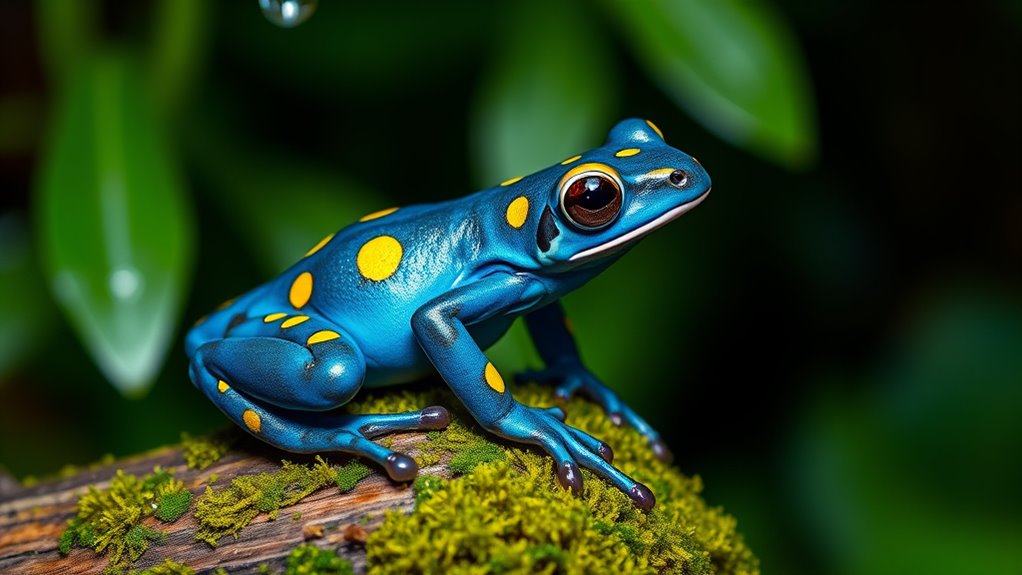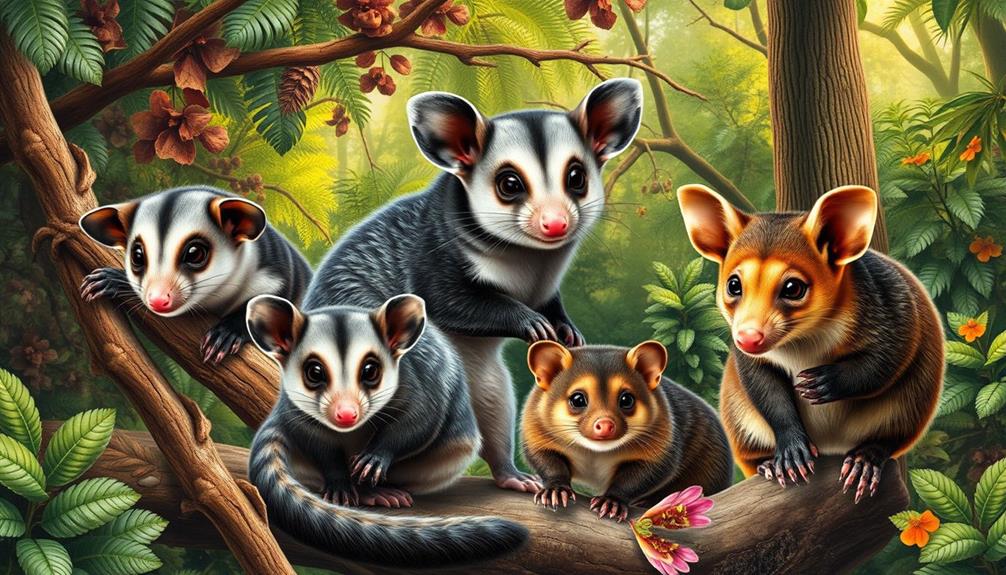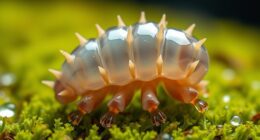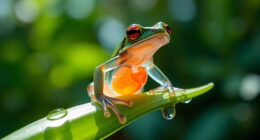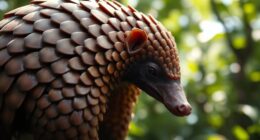Poison dart frogs are toxic mainly due to their diet. They eat specific insects like ants and termites that contain toxic compounds. When they ingest these insects, the frogs metabolize and store the toxins in their skin, which serve as a powerful defense against predators. Their vibrant colors act as a warning signal to potential threats. If you’re curious about how these frogs maintain their toxicity and their unique breeding habits, there’s more to explore!
Key Takeaways
- Poison dart frogs are toxic due to the ingestion of toxic insects like ants and termites in their natural habitat.
- Their bright coloration serves as a warning signal to potential predators, indicating their toxicity.
- Toxic compounds are metabolized and stored in the frogs’ skin, providing a potent defense mechanism.
- Captive frogs lose their toxicity when deprived of their natural diet rich in toxic insects.
- The frogs’ toxicity is a result of ecological adaptation, enhancing their survival in predator-rich environments.

Have you ever wondered why poison dart frogs are considered some of the most toxic creatures on Earth? Their vibrant colors might catch your eye, but it’s the toxins they produce that truly set them apart. These fascinating amphibians are native to the tropical rainforests of Central and South America, where they’ve adapted their habitat to thrive in an environment filled with predators. Their toxicity is a remarkable survival strategy, allowing them to fend off threats and confirm their continued existence in the wild.
One of the key factors contributing to poison dart frogs’ toxicity is their diet. In the wild, they consume a variety of insects, particularly ants and termites, which contain toxic compounds. These compounds, once ingested, are metabolized by the frogs and stored in their skin. This is a prime example of habitat adaptation—by evolving to exploit the toxic properties of their prey, these frogs have turned their environment into a fortress of protection. If you were to see a brightly colored frog in its natural habitat, you’d do well to remember that its brilliant hues signal danger.
Breeding behaviors also play a vital role in the frogs’ lifecycle and the maintenance of their toxicity. During the mating season, male poison dart frogs engage in elaborate displays to attract females. They call out, often with a series of distinctive croaks, and showcase their vibrant colors. When a female selects a mate, she’ll lay her eggs in a safe, moist location—typically among leaves or in tree hollows. The males often stay close to the eggs, guarding them from potential threats, confirming that the next generation is as well protected as possible.
Interestingly, while captive poison dart frogs can lose their toxicity due to a diet lacking in those essential toxic insects, those in the wild maintain their potent defenses. This highlights the importance of their ecological niche. You might find it amazing that such a small creature can wield such power, but it’s a testament to how well they’ve adapted to their surroundings. Their ability to thrive in a complex ecosystem showcases the intricate relationships between species and their environment. Additionally, their survival strategy is akin to payment data protection, illustrating how vital it is for organisms to secure their defenses against threats.
Frequently Asked Questions
How Do Poison Dart Frogs Obtain Their Toxins?
Poison dart frogs obtain their toxins primarily through their diet. You’ll find that they consume certain insects, like ants and termites, which contain dietary toxins. These toxins are then metabolized and secreted through their skin, giving them their characteristic toxicity. If you were to handle one without caution, you’d risk exposure to these potent chemicals. So, understanding their diet is essential to grasping how these frogs become so poisonous in the wild.
Are All Poison Dart Frogs Toxic?
Not all poison dart frogs are toxic; it’s a mixed bag. Toxin variability among species means some are harmless while others pack a punch. Environmental influences play a significant role too; those raised in captivity often lose their toxic traits. So, when you come across these colorful critters, remember that appearances can be deceiving. Some might be just as sweet as they look, without a hint of danger lurking beneath.
Can Poison Dart Frogs Lose Their Toxicity in Captivity?
Yes, poison dart frogs can lose their toxicity in captivity. Since their toxicity largely comes from the specific diet they consume in the wild, when you keep them in captivity and feed them a different diet, they may not produce the toxic compounds. This captivity effect means that without access to their natural food sources, like certain insects, you won’t see the same level of toxicity. So, their diet is vital for maintaining that toxicity.
What Predators Are Affected by Poison Dart Frog Toxins?
If you’re a predator hoping for a tasty meal, you probably shouldn’t pick a poison dart frog! Their toxins act as a fierce chemical defense, sending even the bravest creatures running. Birds, snakes, and even some mammals find out the hard way that these little critters aren’t just pretty faces. So, when you think predator deterrence, remember: the bright colors aren’t just for show; they’re a warning that could ruin your dinner plans!
How Do Indigenous Cultures Use Poison Dart Frogs?
Indigenous cultures use poison dart frogs for their potent toxins in traditional hunting methods. You’ll find hunters extracting the frog’s toxins to coat their darts, enhancing their effectiveness in capturing prey. This practice showcases the frogs’ role in indigenous hunting defense strategies, as the toxins immobilize animals, ensuring a successful hunt. By understanding these unique adaptations, you’re witnessing a remarkable blend of nature and culture that highlights the ingenuity of indigenous peoples.
Conclusion
In summary, poison dart frogs are fascinating not just for their vibrant colors but also for their impressive toxicity. Did you know that some species can contain enough toxins to kill up to 10 adult humans? This remarkable defense mechanism comes from their diet of specific insects in the wild, highlighting the intricate relationship between an organism and its environment. Understanding these connections helps us appreciate the delicate balance of ecosystems and the unique adaptations of these incredible creatures.
